
Swimming
Based on Red Cross skills and levels, the Sewataro Swim Program is a vital part of the overall camp program.
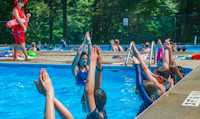
Waterfront Supervisor: Katherine Decker (please visit our Meet the Staff page to find out more about Decker and the Assistant Waterfront Supervisors).
Campers swim twice a day for either two free swim periods or once for instructional swim and once for free swim, depending on their swim level. We strive to develop our campers’ swimming proficiency to the best of their abilities. Our well-trained waterfront staff of over 20 lifeguards and swim instructors, led by our vigilant supervisors, teach children the skills they need to learn to swim and become stronger, more confident swimmers whatever their level. They also oversee the fun at free swim. Our waterfront staff is composed of American Red Cross certified lifeguards, and additional swim instructors, who undergo extensive training by our waterfront supervisors.
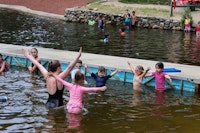
Our instructional swim focuses on Red Cross Level 1–4 skills, ensuring that every camper receives high-quality instruction in fundamental swimming skills and water safety. Once a camper successfully completes Sewataro’s Otter Level, they will “graduate” from lessons and instead enjoy a second free swim period each day.
For lessons, campers are grouped by ability. All campers’ swimming ability will be assessed at the start of their session. After placing children in their appropriate swim groups, we utilize the pond and the pools for swim instruction and free swim. For free swim, campers will enjoy the water while they are carefully guarded. During free swim, camper groups are placed based on height so all campers can stand comfortably. During swim lessons, swim groups are placed depending on level and height of the group.
After camp gets underway, you will receive email notification of your child’s initial swim grouping. A progress report will be emailed to you at the end of your child’s session. In addition, 6 and 8 week campers will receive progress reports at the half-way point of their session.
If you are interested in receiving more detailed information about your child’s progress at any time, we strongly encourage you to call to speak with a Waterfront Supervisor.
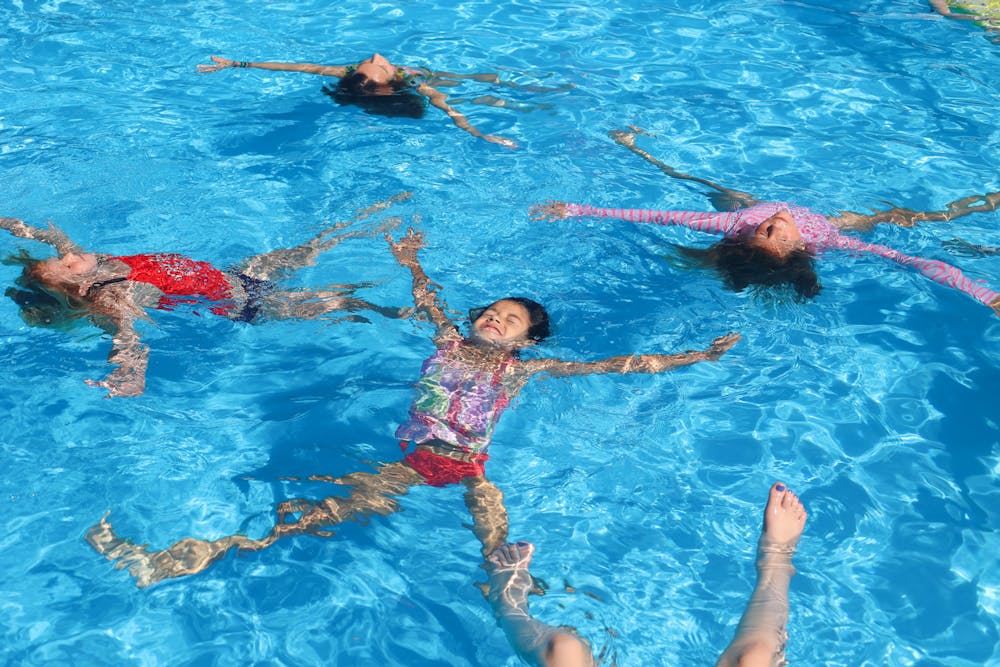
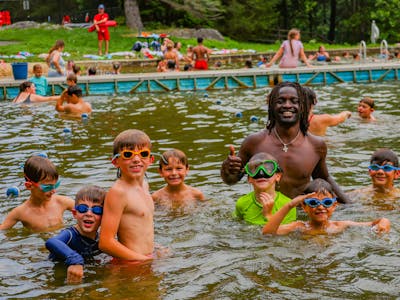
The skills for each level are listed below. Here is the information for the the modifiers for how we evaluate:
- M – Master: there is a solid understanding and ability to demonstrate the skill.
- P – Proficient: The swimmer is able to demonstrate the skills and will be working on refining it.
- A – Approaching: There is a basic understanding of the skill and this will continue to be worked on and practiced.
- N – Not Introduced: This skill has not been fully introduced or reviewed with campers.
Turtle Skills (equivalent to Red Cross Level 1)
Core Skills
- Bobbing, 5 times
- Front Glide, 6 feet
- Back Float, 5 seconds
Supplementary Skills
- Back glide, 6 feet
- Enter water using ramp, steps or side
- Exit water using ramp, steps, side or ladder
- Blow bubbles, 5 seconds
- Collect submerged objects 2 times underwater
- Roll from front to back
- Roll from back to front
On Their Front:
- Flutter kicks, 6 feet
- Alternating arm action, 6 feet
- Combined leg and arm action, 6 feet
On Their Back:
- Flutter kicks, 6 feet
- Alternating arm action, 6 feet
- Combined leg and arm action, 6 feet
Safety Topics
- Who is a lifeguard? What do they do?
- Keeping my body safe around water
- What is an emergency? What does it look like?
- Calling for help
- Sun safety
Frog Skills (equivalent to Red Cross Level 2)
Core Skills
- Front float, 10 seconds
- Back float, 10 seconds
- Freestyle, 15 feet
- Backstroke, 15 feet
Supplementary Skills
- Enter water safely into shoulder deep water
- Exit water safely from shoulder deep water
- Hold breath while fully submerged, 10 seconds
- Collect submerged objects underwater, 3 times
- Bobbing, 15 times
- Front glide, 10 feet
- Back glide, 10 feet
- Roll from back to front to back
- Roll from front to back to front
- Change swimming direction on front or back
- Tread water using arms and legs, 15 seconds, shoulder deep water
Safety Topics
- Who is a lifeguard? What do they do?
- Keeping my body safe around water
- What is an emergency? What does it look like?
- Calling for help
- Look for obstacles before jumping in water
- Sun safety

Seahorse Skills (equivalent to beginner Red Cross Level 3)
Core Skills
- Tread water, 30 seconds
- Free style, 15 yards
- Backstroke, 15 yards
Deep Water Skills (9+ feet deep)
- Jump into deep water, return to start point
- Headfirst entry from sitting position
- Headfirst entry from kneeling position
- Transition into a back float in deep water
- Transition into a front float in deep water
Supplementary Skills
- Rotary breathing, 10 times
- Front float, 30 seconds
- Back float, 30 seconds
- Flutter kick while in streamline, 15 yards
- Dolphin kick while in streamline, 15 yards
- Breaststroke kick, 5 times
- Elementary backstroke kick
Safety Topics
- How to reach and save
- Look for obstacles in deep water water
- Breath control safety
- How to choose an exit point in safe water
- Calling for help
Otter Skills (advanced Red Cross Level 3 - beginner Red Cross Level 4)
Core Skills
- Swim underwater, 15 feet
- Free style, 25 yards
- Backstroke, 25 yards
- Elementary backstroke, 25 yards
- Tread water, 1 minute
Deep Water Skills (9+ feet deep)
- Headfirst entry from kneeling position
- Headfirst entry from stride position
- Headfirst entry from compact position
- Feet first surface dive
Supplementary Skills
- Survival float, 1 minute
- Flutter kick in streamline on back, 25 yards
- Dolphin kick in streamline on back, 25 yards
- Breaststroke kick, 15 yards
- Sidestroke kick, 15 yards
Safety Topics
- How to recognize someone who needs help
- Reaching assist
- Throwing assist
- Look for obstacles in deep water water
- Breath control safety

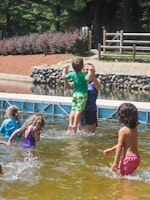
My kids have been taking swim lessons for years, yet this summer, thanks to Sewataro, they have made the most improvement in the shortest time.
Diana
Lexington